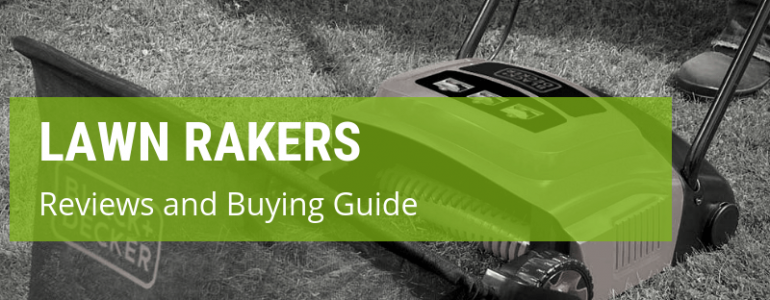Of all the tools a homeowner needs, a lawn raker has to be the most basic equipment to have around the home. To understand why lawn rakers (or scarifiers if you want) are so important, we need to start from the beginning.
In a healthy lawn, it’s completely normal to find some dead plants and grass among the live greenery. This dead grass, roots and moss accumulate to form a thatch which can grow to a few centimetres thick.
Soon enough, the thatch will obstruct the intake of air and water to the roots which will in turn will inhibit the growth of new healthy grass shoots. Before you know it, your once well manicured lawn will be nothing but a patchy shadow of itself.
Raking your lawn regularly is an easy technique used by gardeners to maintain award wining lawns and backyards. For this, we use power rakers or scarifiers which are mower like devices used for efficient removal and collection of thatch.
Using a lawn raker machine is much easier today compared to manual scarification with handrakes. Once a lawn has been raked, fresh grass can have ample space, air and nutrients to grow into a bustling lawn.
When looking for the best lawn raker, it’s important to consider the power source. Petrol powered lawn rakes are more suited for handling larger, wilder lawns while electric models are lighter and quieter for small to medium lawnwork.
Similarly, it helps to choose a machine with an aerator so you can kill two birds with one stone. And if space in the shed is at a premium, you can choose a model that stores easily. A large collection box also means fewer trips to the compost and more time out in the field.
After long hours of intensive scarification on different grass types, lengths, and locations, we’ve compiled a list of the best lawn rakers in the UK market so you can make an informed decision on which unit suits your preferences best.
Lawn Raker Vs Scarifier Vs Aerator
If there’s a group of gardening tools that have people confused, it’s these three right here. But let’s get a few facts straight before we begin – There’s no difference between today’s range of scarifiers and lawn rakers. It’s just that when people refer to rakes, they mean those simple, long, light leaf rakes operated manually.
However, modern lawn rakers are mower-like machines complete with dozens of accessories and functionalities. People in the UK refer to these lawn rakers as scarifiers because, well, we invented the language and will play with it as we see fit.
But for purposes of this article, we will use the terms scarifier and lawn raker as interchangeable. So, what exactly is the difference between a lawn raker and aerator?
a. Aeration
This is one of the simplest and least demanding lawn care techniques of them all. It is a completely different process from scarifying, but it also plays a significant part towards improving the health of your lawn.
As the name suggests, aeration involves poking plenty of holes into the soil all over your lawn. This is done to allow fertilizers, water, and air to penetrate more easily through the thatch and into the soil where they can all be easily absorbed into the root system. Aeration is most commonly done early on in the spring or fall when the lawns are still as not heavily compacted.
Most tools meant for lawn aeration typically include long spikes which can either be smooth or cored for pulling out dirt and turf. But unlike scarifiers which pick up after themselves, aerators are simple and usually leave everything either under or on the lawn surface to decompose naturally, or for you clean up.
b. Scarifiers
Lawnrakers or scarifyers involve more intense lawn care. These machines dig into the grass and create slits through your lawn to remove decaying, organic matter beneath the newly shooting live grass.
This is a crucial part of dedicated lawn care since allowing the thatch to accumulate could lead to a dilapidated yard. Thick layers of thatch tend to block out air and nutrients to the root system which can choke out new growth and undermine the health of your lawn.
How do you know you have a thatch problem? Lawns with an undergrowth and thatch problem tend to feel excessively bouncy and springy. And if you try to look through the grass and into the soil, all you see is a confounding mess of dried grass, moss and decaying plant matter.
Of course, it’s entirely possible to scarify your lawn with a handheld rake. But this is a very labour intensive job that is also inefficient as well since you are unlikely to remove enough thatch. Mechanical lawn rakers offer an easier, faster and more accurate way to detach large areas.
Lawn rakers use curved blades or sprung tines to clear out deeply embedded thatch and organic matter from below the surface without hurting the surface grass. What’s more, some machines even come with spikes to aerate the lawn and a collection bag to make quick work of the removed thatch.
The Best Lawn Raker Reviews
1. BEST OVERALL: Bosch AVR 1100 Verti Cutter Lawn Raker
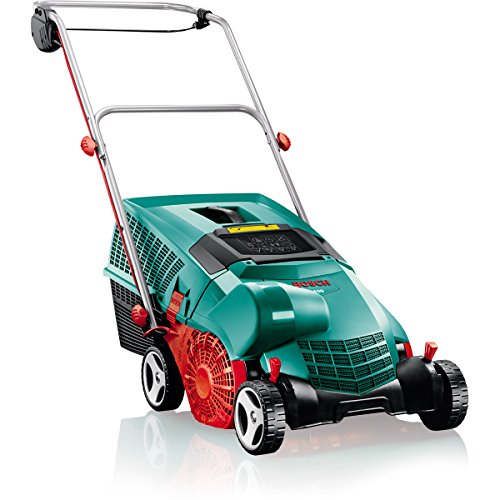
Here’s a solid German entry that excels at every single aspect of lawn raking. Combining high performance technologies with a fair price range, the AVR 1100 Verti Cutter Lawn Raker from Bosch is a well rounded cordless model with a few more practical features than your average Joe. This includes a power packed 1100 watt Powerdrive motor for more torque to deal with especially tangled thatch lawns.
Bosch incorporated 14 tough 32cm width steel blades attached to a cylindrical drum. The drum uses a Jet collection system to quickly blow up all the dead vegetation and thatch into the practical, large 50-litre sized collection box. Another feature worth noting is the space-saving design which allows the Verti Cutter to fold to about 1/3 of its size for easy storage.
What I like about it:
- Powerful 1100 W Motor
- Large 50L grass box
- 4 different height settings
2. BEST ELECTRIC: Bosch ALR Electric Lawn Raker
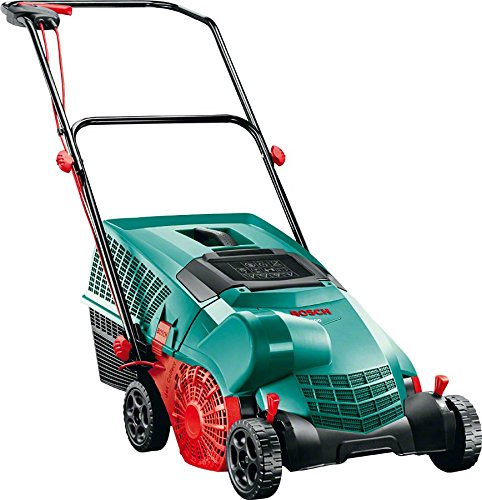
The Bosch ALR Electric Lawn Raker is the less powerful but equally capable smaller cousin of the Verti Cutter. Most of the features are pretty much the same with the key difference being the power. The ALR uses a high torque powerdrive motor to clear weeds, moss, leaves, and thatch.
The ALR also makes use of the same Jet collection system to blow debris into the large 50l grass box. However, it achieves the dethatching by use of 10 double-wound spring tines which can be adjusted through four different raking heights for use throughout the season. And thanks to a compact 40cm frame and Z fold handles, the ALR stores easily.
What I like about it:
- Light compact frame
- Powerful 900W electric engine
- Z fold handles offer space saving storage
3. BEST COMPACT: Flymo Compact 3400 Electric Lawnrake
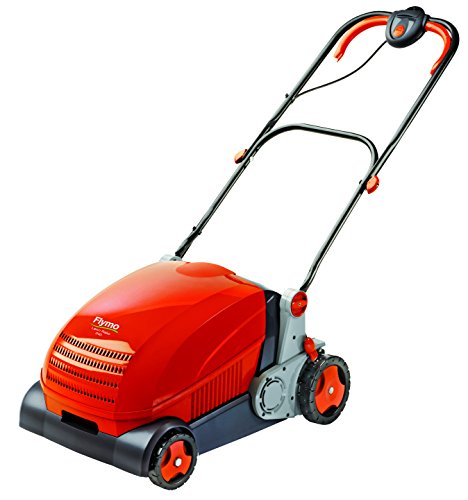
Introducing our compact range of lawnrakers, the Flymo Compact 3400 Electric Lawnrake offers homeowners a quick, simple way to clear thatch and dead grass from lawns. For a compact model, the 3400’s 750 W motor is more than capable of handling heavily packed thatch.
One feature that makes the 3400 stand out is the incredibly versatile raking height settings. The unit incorporates six different levels that vary from -5mm to +8mm. This allows the rake to either go deep into the lawn or just scracth the surface to collect fallen leaves and debris. Speaking of collect, this compact lawn raker has a 34L collection box with a viewing window so you gardeners can check when it’s full. The grass box is the ideal size for people looking to make quick work of small to medium lawns.
What I like about it:
- Compact affordable model for smaller lawns
- Six different raking heights
- Vision window on grass collection box
4. BEST BUDGET: BLACK+DECKER 600W Lawn Raker
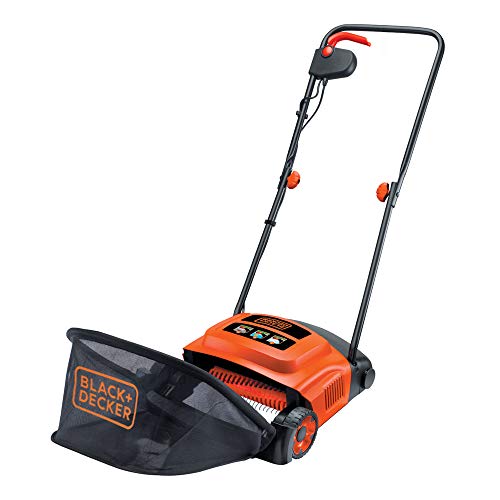
If you’re looking for a reliable, budget friendly machine to do some light yardwork, then the BLACK+DECKER 600W Lawn Raker is right up your alley. Despite being the cheapest model on the list, this raker has some pretty impressive and versatile features. The 600 W motor is powerful enough to clear off thatch that hasn’t compacted for too long which makes it ideal for all year yard maintenance.
Like some of the best models on this list, the lawn raker from Black and Decker also comes with variable working heights for pulling out thatch, raking up leaves or just teasing left over grass. The safety features on the GD300 are also worth mentioning. They include a safety lock off switch and a cable management system that keeps the cable away from the tool mechanism.
What I like about it:
- Best budget model on our list
- Safe and intelligent design
- 3 Variable height settings
5. BEST PETROL: AL-KO 38P Combi-Care 2-in-1 Petrol Lawn Raker
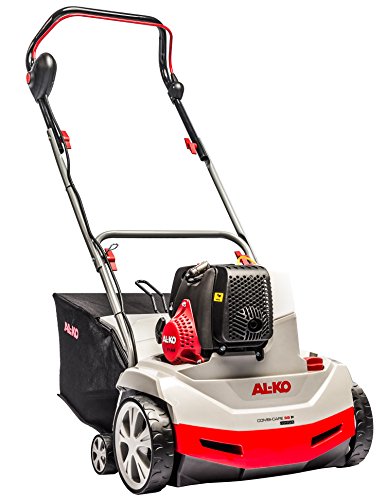
If you’re looking to scarify large areas such as golf courses or are a professional gardener, then nothing but a petrol powered dethatching beast will do. The 38 P Combi Care is a massive 20Kg 2 in 1 lawnraker from AL-KO powered by a 53cc engine. Complete with a scarifier and aerator, this top notch unit is suitable for both small and large lawns as well as everything in between.
The 38P packs a unique range of features including two sets of drums which can be interchanged for scarifying and aerating purposes. The best part is that you don’t need any tools to change these drums. The strong suction created by the engine blows removed thatch into the large 55 litre hopper that can compact a lot of material before filling up. With 5 cutting levels and a wide 37cm scarifying width, the AL-KO 38p is the SUV of the lawn rakers.
What I like about it:
- Powerful 53cc petrol engine
- Extra large 55 litre collection box
- 2-in-1 function for dethatching and aerating
Frequently Asked Questions
Q: How to use an electric lawn raker?
This machine works by teasing the moss and root out of the grass system, and it is fairly easy to use. Simply run it over the grass, having first made sure that the height adjustment is set at the right level.
When you reach the end of the area you are working on, turn around and go back in the opposite direction – don’t go at right angles as this will damage the ground too much.
As you progress and remove the tangles in your lawn you can lower the height of the blades, but try to keep the tines from actually going into the soil as it can damage or even break them.
Q: What is the difference between scarifier and lawn raker?
Both these machines look like a lawn mower, and work in a similar principle – you push them along your lawn to achieve the desired effect. Both are used to improve the health of your lawn and garden.
Lawn rakers have a plastic cylinder that is covered in sprung metal tines, which can pull out moss and thatch from your lawn in a combing action. Lawn scarifiers have the same plastic cylinder, but in their case it is covered with knife blades, which are capable of cutting into the lawn to remove thatch and moss. You can also use your scarifier on its lowest setting, to cut into the soil and improve aeration.
Q: How to change lawn raker tines?
- Remove the roller that holds the tines (there should be a split pin holding everything together).
- Take a small bladed screwdriver and remove the circular spring washer – don’t try to remove the split pin at the other end as it may be much stiffer than the first.
- Remove all but one of the tines – leave the last one is as it will be a guide on how to fit the replacements. Do this by inserting a screwdriver at the base of the tine and levering it off.
- Take your replacement kit (you can get these from a hardware store, your lawn raker manufacturer, or online) and insert the new tines carefully into their holders.
- Slot the plastic circular end back onto the spindle, and replace the end cover plate. Tap it down (lightly!) with a hammer to make sure it is secure.
- Replace the circular spring washer from Step 2, and flatten it down slightly so that it grips the spindle.
- Fit the roller back into the body of the lawn raker and replace the split pin from Step 1.
Spray lightly with WD-40 or similar lubricant oil, to ensure everything runs smoothly.
